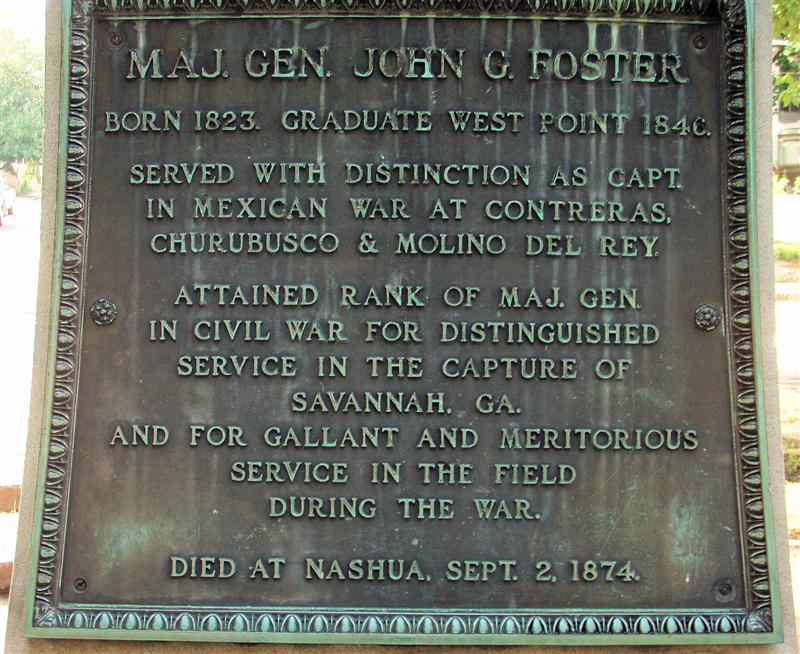
Maj Gen John G. Foster - Nashua, NH
Posted by:  silverquill
silverquill
N 42° 45.946 W 071° 27.891
19T E 298327 N 4737750
This statue tucked away in a small neighborhood honors Nashua native John Gray Foster. Fighting for the Union, he distinguished himself at Ft. Sumpter, the defense of Washington, DC, the surrender of Savannah among many other strategic campaigns.
Waymark Code: WM58RR
Location: New Hampshire, United States
Date Posted: 11/29/2008
Views: 25

MAJ. GEN. JOHN G. FOSTER
Born 1823. Graduate West Point 1846.
Served with distinction as Capt.
in Mexican War at Contreras,
Curubusco & Molino del Rey.
Attained rank of Maj. Gen.
in Civil War for distinguished
service in the capture of
Savannah, GA.
and for gallant and meritorious
service in the field
during the war.
Died at Nashua, Dec. 2, 1874
From the Wikipedia:
Foster was born in Whitefield, New Hampshire. When he was ten, his family moved to Nashua, where he attended the local schools before enrolling in the Hancock Academy. He graduated from West Point in 1846, fourth in his class of 59 cadets and served as an engineer during the Mexican-American War. He served under Winfield Scott and was severely wounded at the Battle of Molino del Rey. He won two brevet promotions for bravery. After the war, Foster returned to West Point as an instructor. In 1858 he was on engineering duty in Charleston Harbor, where he helped in the construction of Fort Sumter.
Civil War
Promoted to captain of U.S. engineers, Foster was in command of the garrison at Fort Moultrie when the Civil War began. He immediately transferred his small force to Fort Sumter and became second-in-command to Maj. Robert Anderson during the Battle of Fort Sumter. Foster was appointed a brigadier general of volunteers on October 23, 1861, and commanded the 1st Brigade in Maj. Gen. Ambrose Burnside's North Carolina Expedition. He was conspicuous in action at the battles of Roanoke Island and New Bern. After the Battle of Roanoke Island, the Confederate Fort Bartow was renamed Fort Foster in honor of General Foster.
After General Burnside was transferred to Virginia, Foster assumed command of the Department of North Carolina. He was promoted to major general of volunteers on July 18, 1862, and led the Goldsboro Expedition. During Confederate Lieutenant General James Longstreet's Tidewater Campaign, upon hearing of a planned Confederate attack on Washington, North Carolina, Foster personally assumed command of the defenses there. When D. H. Hill demanded the surrender of Washington, Foster defiantly replied, "If you want Washington, come and get it." Hill's forces besieged the garrison and two Union relief expeditions were turned back. Foster escaped the besieged city in order to personally lead a relief column back. Hill withdrew his forces shortly afterward however. In December, Foster won a strategically important fight at the Battle of Goldsboro Bridge, resulting in the destruction of an important railroad bridge on a vital Confederate supply line.
In 1863, Foster was sent to Tennessee to assume command of the Department of the Ohio and its corresponding Army of the Ohio. He was in command only for a short time before he was badly injured in a fall from his horse. Upon his recovery, he took command of the Department of the South and aided in forcing the surrender of Savannah, Georgia. He was making preparations for the surrender of Charleston, but his wounds forced him to relinquish command to Maj. Gen. Quincy A. Gilmore. Foster was placed in command of the Department of Florida at the end of the war, receiving a promotion to the rank of major general in the volunteer service and brevet major general in the regular army.
After the war, Foster remained in the army, being promoted to lieutenant colonel of engineers in 1867. Promoted to colonel of engineers in 1871. He was involved in military and underwater surveying and became an expert in underwater demolition, publishing a definitive manual on the subject in 1869 that became the acknowledged reference work. From 1871 until 1874, he was assistant to the Chief of Engineers in Washington, D.C. His final post was a superintendent of the Harbor of Refuge on Lake Erie.
Foster died in Nashua, New Hampshire, and was buried in Nashua Cemetery.
The John G. Foster Post #7 of the Grand Army of the Republic in Nashua was named in his honor. In 1900, Fort Foster in Maine was named in his memory. It is preserved as a park.
Major General John G. Foster